So in this second of my posts on solid fuel grain regression I’ll cover more complex grain core shapes, although the process is not overly dissimilar to the methods discussed previously. An average web length is found and an incremental distance is then defined, this distance is then used to regress each point of the core, with the grain cross-sectional area and edge length found at each point as before.
Star Grain
The star grain can be defined using the following geometry data shown in this diagram,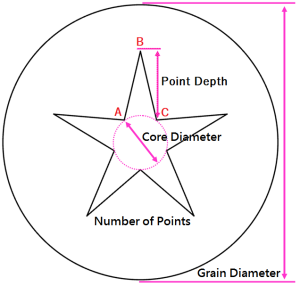 consisting of a core diameter, number of points and the overall grain diameter.
consisting of a core diameter, number of points and the overall grain diameter.
An initial star point is created composed of three points, two base points that lie on the core radius AC and the top of the point at B. These points are defined in terms of a pair of i,j coordinates using the following, where cr is the core radius and d is the point depth.
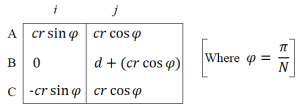
These points are then rotated from 1 to N in a loop to create the completed core, remembering that each point requires increasing the angle ψ by multiplying it by whatever point number the loop condition is at that moment. This rotational matrix is shown below and applied to where the rotated coordinates are given by i’ and j’.

The edge length of each star point is just twice the length of the vector AB and multiplied by the number of points. Similarly the area of each point is equal to the triangle formed by ABC, (the curved edge AC is equivalent to the circumference of the core divided by the number of points), the total core area can then be subtracted from the circle formed by the grain diameter to find the cross-sectional grain area.
The next regression point can then be found by adding the incremental distance onto the core radius and repeating the process. (Note once the point of the star burns through the grain, Point B is modified into two new points B1 and B2. Their locations found using the process covered in Part 1 of this series, but the overall method remains the same).
So onto the good stuff, here’s a few of the regression contours for different star grain configurations, interestingly the regression doesn’t produce a neutral burn as predicted (but I’ll go over this in Part 3), I have never used this kind of grain geometry in the past so have no experience. I would like to modify the program to account for star-shaped grains with curved edges and radiused ends, rather than straight sides and pointy points.
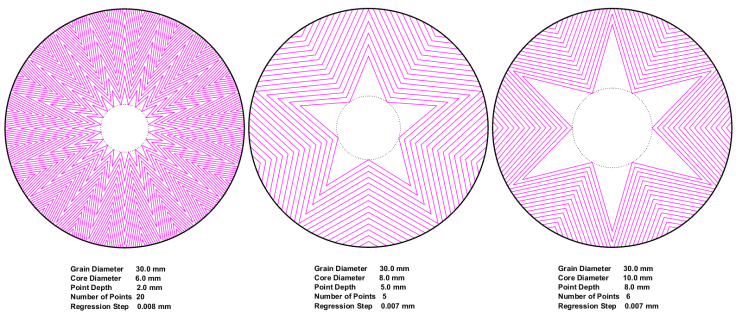
Finned and Slotted Cores
Without delving into more trigonometry and mathematics, the finned core and slotted core (sometimes referred to as a FinoCyl or Pseudo-FinoCyl) geometries are created the same way as the star core above, except this time with four coordinate points to create three lines that describe the fin/slot, being AB, BC, CD respectively. The geometry of these cores are shown above, and as you can see they are the inverse of each other. Regression takes place by either; subtracting the incremental distance from each side of the fin, or adding it to each side of the slot, together with an increase in the core radius as before.
Examples of the regression analysis of both core types are shown below. As with the star core model above, I’d like to further improve this model with the ability to handle radiused edges.
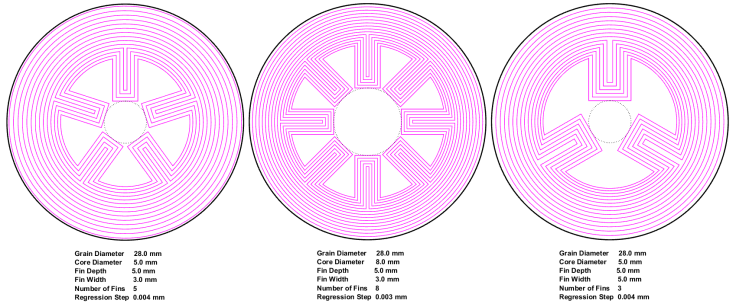
It is interesting to note that the finned core creates a large burning surface area at the beginning is quite and the fins burn through relatively quickly, leaving the core to regress as a simple circular core.
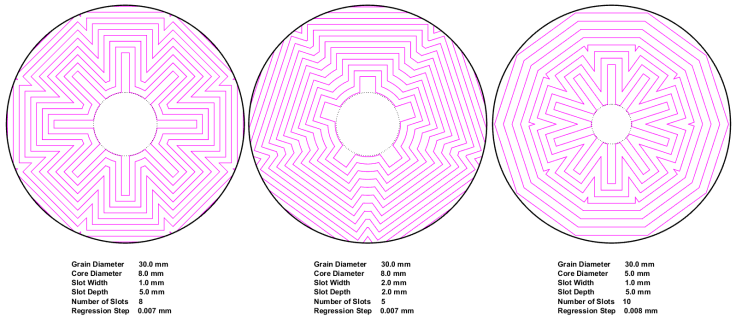
An interesting observation from the slotted core regression model is there appears to be a point at which rate of the regression of the radius of the initial core between the fins will either disappear quickly or persevere long enough to create triangular sliver elements at the end of the burn. If this curved edge vanishes midway through the burn then the core begins to approximate a circular core (as seen on the far-right image above) albeit a very low resolution one with straight edges. These peculiarities do manifest themselves later in the pressure and thrust simulations, again I will cover this in later posts.
Again I’d like to note that I’ve only covered the basic aspects of modelling the grain regression and there are other factors that need to be considered. If this is something you want to try then you’d need to tailor your approach to whatever programming language you use, this could even be done using Excel if you were so inclined. Next time I’ll show how to make sense of the data created during these grain regression simulations.
Sarah
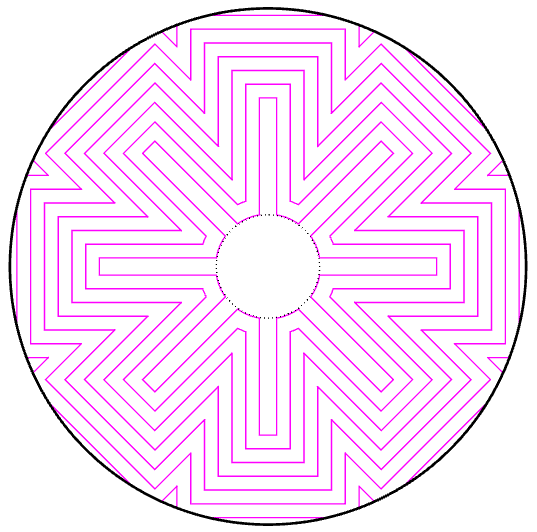


Leave a comment